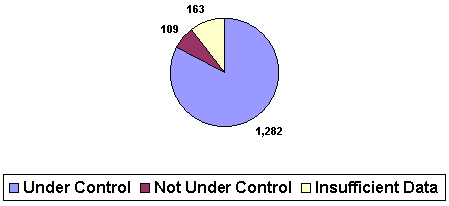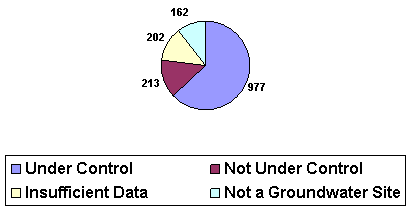Environmental Indicators
The 1993 Government Performance and Results Act (GPRA), holds federal agencies accountable for using resources wisely and achieving program results. Superfund's environmental indicator (EI) measures are the Site-Wide Human Exposure EI and the Contaminated Groundwater Migration EI.
Superfund Environmental Indicators are measures of program performance used to communicate tangible progress made in protecting human health and the environment through site cleanup activities.
Current Superfund Environmental Indicators are used to report:
- The number of sites at which current human exposure to contamination is under control or falls within the levels specified as safe by EPA; and
- The number of sites where contaminated ground water migration has been controlled to prevent further spread of contaminants, prevent human exposures, and prevent unacceptable discharge levels to surface water, sediments, or ecosystems.
Download the Superfund Environmental Indicators Guidance Human Exposure Revisions - March 2008 (1.6MB, PDF)
Site-Wide Human Exposure Environmental Indicator
What does the Site-Wide Human Exposure EI measure?
The Site-Wide Human Exposure (HE) environmental indicator is designed to document long-term human health protection on a site-wide basis by measuring the incremental progress achieved in controlling unacceptable human exposures at a Superfund site.
What are the progress categories to which NPL sites are assigned for the Site-Wide Human Exposure Indicator?
- Current human exposure under control - Sites are assigned to this category when assessments for human exposures indicate there are no unacceptable human exposure pathways and the Region has determined the site is under control for current conditions site wide.
- Insufficient data to determine human exposure control status - Due to uncertainty regarding exposures, one cannot draw conclusions as to whether human exposures are controlled. Sites are typically assigned to this category when responses have not been initiated or response actions have been initiated but have not yet generated reliable information to make an evaluation for this indicator - i.e., there is not sufficient information to determine whether there are any current, complete unacceptable human exposure pathways at the site, therefore no determination is possible.
- Current human exposures not under control - Sites are assigned to this category when data indicate that there are complete human exposure pathways that present unacceptable exposures to humans, and actions have yet to be completed to address these human exposure pathways for the entire site. Unacceptable human exposures can be controlled by:
- Reducing the level of contamination in the environment to a level that EPA has specified as safe;
- Controlling or eliminating the migration of a contaminant so that it does not reach a location where humans may come into contact with it; and
- Preventing humans from contacting contaminants, or controlling human activity patterns (e.g., by reducing the potential frequency or duration of exposure).
How often is a site's Site-Wide Human Exposure EI status reviewed?
The human exposure status at a site is reviewed annually by October 15, or at any time site conditions change.
How can I learn the Site-Wide Human Exposure EI status at sites in my area?
Perform a search of CERCLIS Hazardous Waste Sites to identify the human exposure status at sites in your area.
What is the status of the Site-Wide Human Exposure EI as of the end of FY 2007?
Site-Wide Human Exposure Under Control at NPL Sites as of October 2007

Contaminated Groundwater Migration Environmental Indicator
What does the Contaminated Groundwater Migration EI measure?
The GM EI documents whether contamination is below protective, risk-based levels or, if not, whether the migration of contaminated ground water is stabilized and there is no unacceptable discharge to surface water and monitoring will be conducted to confirm that affected ground water remains in the original area of contamination. This indicator normally is limited to sites with known ground water contamination.
A conclusion of "migration of contaminated ground water under control" generally indicates that all information on known and reasonably expected ground water contamination has been reviewed and the above conditions are met.
What are the categories to which NPL sites are assigned for the Contaminated Groundwater EI measure?
- Contaminated ground water migration under control - indicates that all information on known and reasonably expected ground water contamination has been reviewed and that the migration of contaminated ground water is stabilized and there is no unacceptable discharge to surface water and monitoring will be conducted to confirm that affected ground water remains in the original area of contamination.
- Insufficient data to determine migration control status - Due to uncertainty regarding contaminated groundwater migration, one cannot draw conclusions as to whether the migration of contaminated ground water is stabilized.
- Contaminated ground water migration not under control - indicates that all information on known and reasonably expected ground water contamination has been reviewed and that the migration of contaminated ground water is not stabilized.
How often is the Contaminated Groundwater EI status updated?
The Migration of Contaminated Ground Water Under Control status at a site is reviewed annually by October 15, or at any time site conditions change.
How can I learn about the status of Contaminated Groundwater EI sites in my area?
Perform a search of CERCLIS Hazardous Waste Sites to identify the status of Migration of Contaminated Ground Water Under Control Sites in your area.
What is the status of the Contaminated Groundwater Migration EI as of the end of FY 2007?
Contaminated Groundwater Migration Under Control at NPL Sites as of October 2007

Superfund Help: Acronyms | Topics | Frequent Questions | Publications | Sitemap
![[logo] US EPA](https://webarchive.library.unt.edu/eot2008/20081029195124im_/http://www.epa.gov/epafiles/images/logo_epaseal.gif)